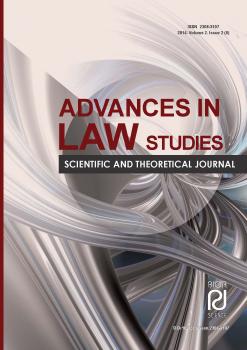Moskva, Moscow, Russian Federation
The article analyzes the international legal developments related with the introduction of the Kyrgyz Republic in international organizations within regional integration. Briefly discusses the various aspects of the attractiveness of the Eurasian integration for Kyrgyzstan, as well as some of the factors of the internal environment. Conducted a brief analysis of the agreement on the Eurasian Economic Union. And defined the status of the Eurasian Economic Union.
Eurasian economic integration, the Eurasian Economic Union, the Customs Union, the Eurasian Economic Space, an international organization, supranationality.
В современных условиях глобализации основным способом согласования, переплетения и со-стыковки публичных интересов на уровне государств является их экономическая интеграция, т.е. процесс хозяйственно-политического объединения стран на основе разделения труда между национальными экономиками и развития глубоких, устойчивых взаимосвязей между ними [1, с. 10].
Особый интерес на данном этапе глобализации имеет новейшее интеграционное объединение на территории стран СНГ — Евразийский экономический союз (далее — ЕАЭС), Договор о котором вступил в силу с 1 января 2015 г. Для полного представления картины проведем краткий экскурс по хронологии развития ЕАЭС. Договор о ЕАЭС был подписан Президентами Республики Беларусь, Республики Казахстан и Российской Федерации 29 мая 2014 г. в Астане. «Первоначальными членами союза явились Белоруссия, Казахстан и Россия. 3 октября 2014 г. Президент РФ В.В. Путин, 9 октября 2014 г. Президент Белоруссии А.Г. Лукашенко и 14 октября 2014 г. Президент Казахстана Н.А. Назарбаев подписали национальные законы о ратификации договора о ЕАЭС. ЕАЭС создан для укрепления экономик стран-участниц и их «сближения друг с другом», для модернизации и повышения конкурентоспособности стран на мировом рынке. 10 октября 2014 г. главы государств — членов ЕАЭС подписали договор о присоединении Армении к Союзу. 4 декабря 2014 г. Парламент Армении ратифицировал договор о присоединении страны к ЕАЭС [2, с. 158]. Членство в ЕАЭС отсчитывается со 2 января 2015 г.
1. Shumilov V.M. Mezhdunarodnoe ekonomicheskoe pravo v epohu globalizacii [International economic law in the era of globalization]. Moscow, Mezhdunarodnie otnosheniya Publ.,2003.
2. Starodubcev G.S. Eurasian Union: from idea to reality. Vestnik Permskogo universiteta. Yuri-dicheskie nauki [Bulletin of Perm University. Legal sciences], 2015, vol. 1 (27).
3. The Treaty on the Eurasian Economic Union. URL: https://docs.eaeunion.org/ru-ru/Pages/DisplayDocument.aspx. (in Russian)
4. Lenkov I.N. The Genesis of the integration processes in the region of the EAEU. Bankovskie uslugi [Banking services], 2015, vol. 2.
5. Shumilov V.M., Boklan D.S., Lifshic I.M. Legal innovations of the Treaty on the Eurasian Economic Union. Rossiyskiy vneshneekonomicheskiy vestnik [Russian external economic Bulletin], 2015,vol. 4.
6. Anufrieva L.P., Bekyashev K.A., Moiseev E.G. et al. Mezhdunarodnoe publichnoe pravo [Public International law]: 5th ed., revised and expanded. Moscow, Prospekt Publ., 2008.
7. Neshataeva T.N. Mezhdunarodnie organizacii i pravo: Novie tendencii v mezhdunarodno-pravovom regulirovanii [International organizations and law: emerging trends in international legal regulation]. Moscow: Delo Publ., 1998.
8. Skriba A.S. Challenges and prospects of Eurasian integration after the Ukrainian crisis . Vest-nik mezhdunarodnih organizacii: obrazovanie, nauka, novaya ekonomika [Bulletin of inter-national organizations: education, science, new economy], 2014, vol. 9,vol. 3.
9. Panina E.V. Socio-economic and legislative aspects of the development of the Eurasian eco-nomic Union. Evraziyskaya integraciya: ekonomika, pravo, politika [Eurasian integration: economics, law, politics], 2012,vol. 12.
10. Iskakova Z.D., Kabasheva N.V., Esenova G.Zh. About integration participants of Eurasian Economic Union: expectations and implementation mechanisms. Mezhdunarodniy zhurnal prikladnih i fundamental’nih issledovaniy [International journal of applied and fundamental researches], 2014, vol. 10-3.
11. Lukyanova V.Yu. Pravovie problem formirovaniya mezhgosudarstvennih obyedineniy (na primere zoni svobodnoy torgovli i Tamozhennogo soyuza EvrAzES) [Legal problems of formation of interstate associations (for example, free trade area and Customs Union of the EAEU). Moscow, Ankil, 2012.
12. Irishev B., Kovalev M. The Future of the EAEU: the difficult search for balance and growth. Vestnik associacii belorusskih bankov [Bulletin of the Association of Belarusian banks], 2014, vol. no 31-32.
13. Shumilov V.M. On the periodization of international law in the context of the civilizational approach: Russia and the West. Evraziнskiy yuridicheskiy zhurnal [Eurasian law journal], 2014,no 10.
14. Kobzar’-Frolova M.N. The debate on the legal regulation of relations in the EEU. Aktual’nie problem administrativnogo i administrativno-processual’nogo prava [Topical issues of ad-ministrative and administrative procedural law]: The proceedings of the annual all-Russian scientific-practical conference: in 3 parts. St. Petersburg, Saint-Petersburg University of Rus-sian Interior Ministry, 2015.
15. Bekyashev K.A. The EAEU: the international (intergovernmental) organization or interna-tional (inter-state) integration? Evraziyskijy uridicheskiy zhurnal [Eurasian law journal], 2014,vol. 11 (78).
16. Radzhabova Z.K., Radzhabova Z.O. Prospects of development and problems of economic re-lations and monetary policies of the countries within the Eurasian Economic Union, EAEU. Sovremennie problem nauki i obrazovaniya [Modern problems of science and education], 2015, vol. 1.

















